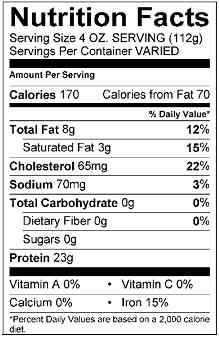An In-depth look into Food Labels
Grocery shopping can be a decision nightmare with all the food labels to decipher. This email will expose and decipher some of those cryptic claims to hopefully make you a more savvy grocery shopper.
No Preservatives
Preservatives are added to foods to extend the shelf life of the product. Some preservatives are natural, such as citric acid (in lemons), ascorbic acid (vitamin C) and acetic acid (vinegar), and some are chemical such as sodium metabisulfite. Preservatives are regulated by the Canadian Food Inspection Agency. Some people make a choice to choose foods without chemical or natural preservatives. However, when a label says “no preservatives”, this does not include sugar and salt. Make sure to read the labels carefully to prevent choosing “preservative free” foods that may be higher in salt and sugar than you would desire.
Organic
Organic food labels provide insight into the way in which the food was produced. Organic foods are produced in the most natural way possible, without the use of synthetic fertilizers or pesticides or without the use of antibiotics or hormones. Foods with multiple ingredients can be labeled as organic if they contain 95% organic ingredients. There is no evidence that Organic foods are nutritionally superior, although they may seem that they are more nutritious. Therefore, be mindful that organic cookies, ice cream and chocolate are still cookies, ice cream and chocolate.
Gluten-Free
Individuals with Celiac disease must avoid foods containing gluten, as this causes intestinal inflammation. Individuals who have gluten sensitivity should also avoid gluten. Gluten is a protein found in wheat, spelt, barley and rye. It is what gives the dough of these grains an elastic texture once kneaded with water.
Gluten-Free has become a phenomenon in the food world, giving wheat a bad reputation. Some people are under the impression that going gluten-free can help with weight loss. Calorie for calorie, gluten-free diets won’t lead to weight loss compared to diets containing gluten. However, they may reduce bloating if you have underlying gluten sensitivity.
Percent Daily Value
The Percent Daily Value is a tool to help you make decisions about which foods/brands to choose based on nutrient content. Rather than looking at the amount of a nutrient in terms of grams or milligrams on a nutrition facts label, pay attention rather to the Percent Daily Value. A small amount of a nutrient is considered less than 5%, a lot of a nutrient is considered more than 15%.
Aim for less than 5% of:
– Total fat
– Saturated fat and Trans fat
– Sodium
Aim for more than 15% of:
– Fibre
– Iron
– Calcium
– Vitamin A
Using Food Labels to help you choose foods that meet your dietary needs can be challenging. Hopefully this information will make your decision making a little easier. For more information on nutrition labels, you can visit the following websites:
Health Canada: www.hc-sc.gc.ca
Eat Right Ontario: www.eatrightontario.ca
Canadian Food Inspection Agency: Guide to Food Labeling and Advertising

